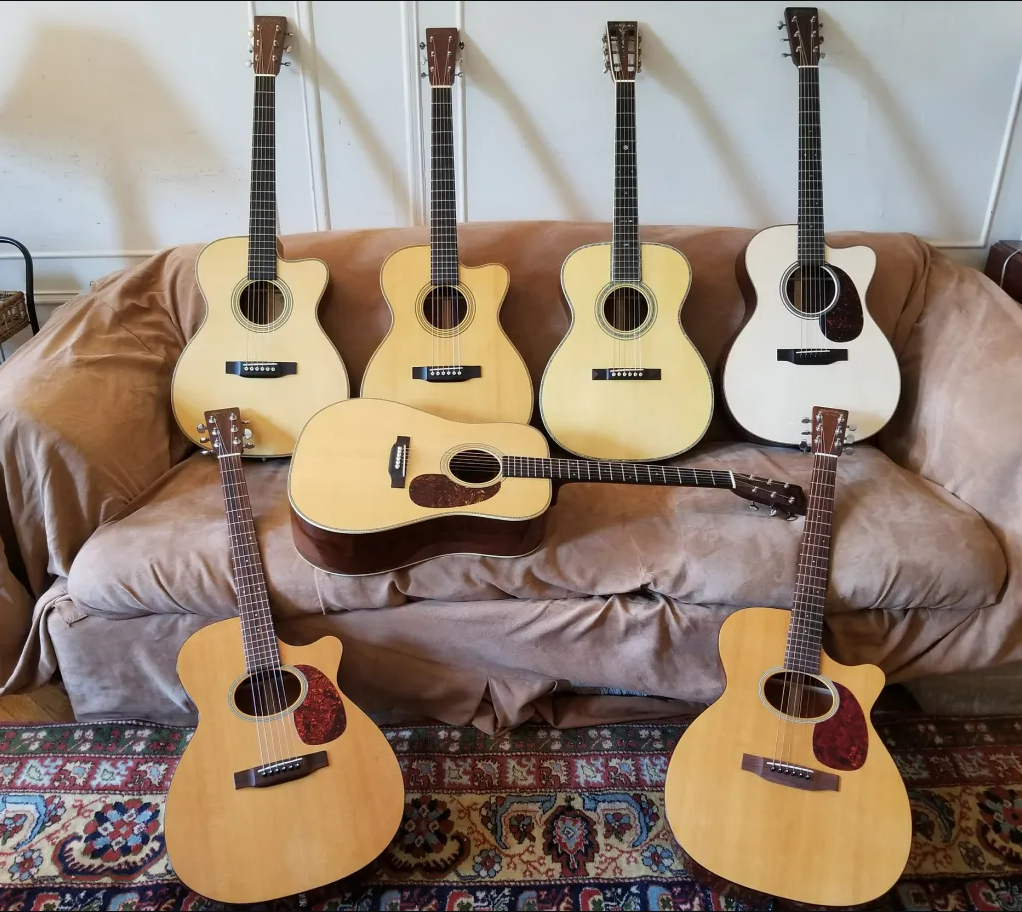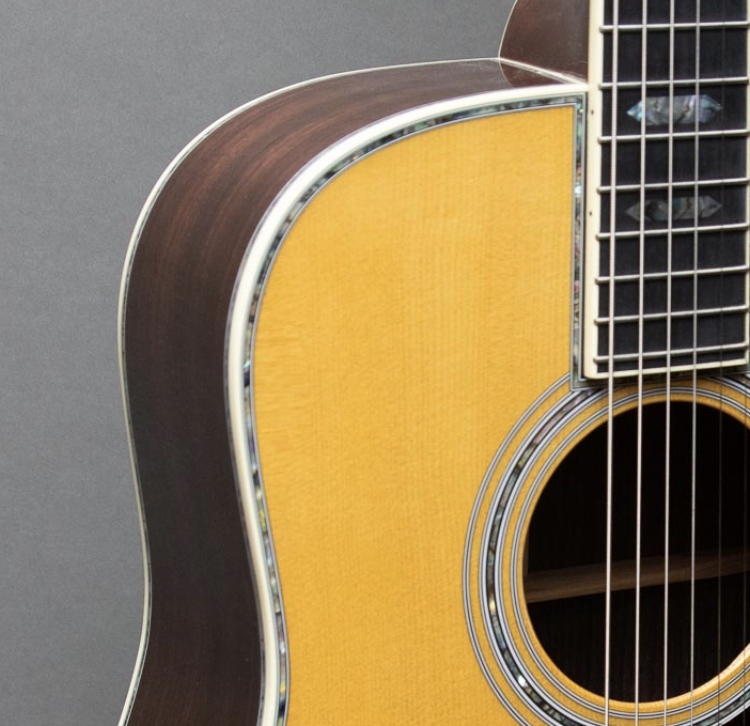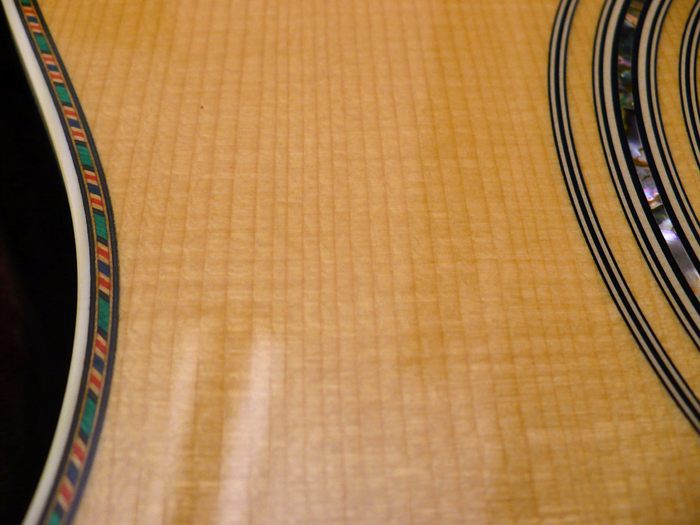
Ordering a Custom Martin the Right Way – Part II
We shall begin where we left off, with more common customizations that relate to our previous discussion of body shapes, while introducing unusual options to consider as you plan out your perfect custom Martin guitar.
Bracing
Martin’s world-famous X Bracing comes in more than one variety. The following specifications can be combined to achieve certain goals for tone production, in concert with the body size and tonewoods chosen for a particular instrument.
Forward Shifted Bracing
Martin guitars with larger bodies are today made with forward-shifted bracing, as used at Martin during their Golden Era of the 1930s. This means the main X-brace crosses the center of the top approximately 1” from the sound hole. Forward-shifted bracing increases body resonance and bass response by allowing the area around and below the bridge plate more freedom to vibrate while producing soundwaves. Forward-shifted bracing accentuates that deep, throaty characteristic that sets Martin guitars apart from the rest of the acoustic guitar herd that’s heard across popular music of all kinds.
For those who prefer the sound of Martin standard Dreadnoughts made between 1960 and 2018, you may custom order the non-forward bracing pattern. And for those who prefer the sound of Martin Dreadnoughts made between 1939 and 1960, you may custom order the rear-shifted bracing pattern that had the X brace even farther back, for punchy, well-defined bass and midrange. Modern Martins with rear shifted bracing include the D-18 Authentic 1939 Aged, and retired artist models honoring Dan Tyminksi and C. F. Martin IV.
Scalloped vs. Non-Scalloped Top Braces
Scalloping means that slopes are carved into the center and edges of each brace and tone bar, leaving one or two higher points (depending upon the length of the brace) for stability. Scalloping makes the braces more flexible, leading to a greater flexibility of the top.
Non-scalloped bracing, as used on the D-28, is stiffer than the scalloped bracing used on the HD-28 and most other Martins. Guitars with non-scalloped braces have strong, focused fundamental notes that stand up and out from the body resonance.
Guitars with scalloped braces have more reverberating body resonance that rises up and around the fundamental notes, especially when a chord is left to sustain, or picking patterns continue slowly enough for the harmonic overtones to build and sustain. In short, it adds a natural reverb to the sound of the guitar.
An additional custom option for scalloped bracing is Golden Era style scalloping, as used on the Modern Deluxe Series, which removes even more wood from the bracing during scalloping, for even more responsive body resonance, leading to a voice more like a pre-war Martin.
When it comes to smaller body guitars, scalloped bracing is recommended in all cases. This is because it maximizes the responsiveness of the smaller spruce top.
Brace Size
The D-35 also has non-scalloped bracing, but it has 1/4" bracing, referring to the width of each brace or tone bar, while the D-28 has 5/16” bracing. The former provided a different kind of flexibility from scalloped 5/16” bracing. The D-35 has treble notes even more focused than those from the D-28, while having a rounder, more pronounced bottom end. Add in scalloped bracing, and just as the HD-28 has more resonance than the D-28, the HD-35 with its light, scalloped 1/4" bracing under that massive Dreadnought soundboard is supercharged with bassy body resonance. When it comes to larger bodies like size D, J, and GPC, if you want as lush and reverbative voice with maximized bass response, then scalloped, forward-shifted 1/4" bracing is the way to go. But most players are satisfied with the 5/16” bracing used on classic Martins like the D-45 and D-18. Please give us a call to discuss the top bracing best for the tone you seek.
Cutaway
Almost every body size available in the Custom Shop can be ordered with a “cutaway,” which removes a portion of the top and back to provide access to the fingerboard that extends up towards the sound hole. But did you know there was more than one cutaway available?
Martin was late in offering flattop guitars with a cutaway, starting in the 1980s. Back then, they had a much deeper cutaway than you see on Martins today, because those first cutaway models were fitted with a 22-fret neck, like an electric guitar! This required an oval sound hole to make room for those extra two frets.
Here is a photo of a pair of 1990s 000C-16s owned by Spoon Phillips. They sit in front of his collection of custom Martin guitars, featuring modern Martin cutaways ordered from Maury’s Music.

Martin will accept custom orders for the 22-fret fingerboard and oval sound hole to this day, on certain body sizes. Give us a call if you want to know more. The 22 frets require a long-scale neck, and is limited to specific sound hole rosette inlay that can be achieved with the oval sound hole. This brings us to the next section of options from the Custom Shop.
Top Shading
Before we get into the more elaborate visual appointments, we should take the time to mention that Martin offers multiple cosmetic finish options. Most Martins come with Aging Toner on the spruce soundboard, as used in the Standard Series. But having the natural hue of the spruce is always an option. Then there are the burst finishes. These include the most popular 1935 Sunburst and Amberburst, as well as the Autumn Sunset Burst used on the CEO-7, and the Whiskey Sunset Burst on the DSS-17 Whiskey Sunset and 000-17 Whiskey Sunset.
Stylish Trim
Martin’s traditional, official model Styles denote the cosmetic appointments that give each style their signature looks. For example, in today’s Standard Series, 28 Style appointments include Antique White body binding and Bold Herringbone purfling inlaid around the edge of the top, and the Long Pattern Diamonds and Squares fret position markers on the fingerboard made from abalone shell, as seen on the D-28 and OM-28. 18 Style appointments include faux tortoise shell body binding, 18 Style black and white ply purfling around the edge of the top and Art Deco dot fret position markers on the fingerboard, made from abalone shell or mother-of-pearl, as seen on the D-18 and 00-18.
Upscale abalone shell is used for trim on showcase models like the D-45 and the 000-42 Modern Deluxe. All such trim can be mixed and matched, or cherry-picked to deck out your one-of a kind Martin.
Binding
Binding is seen around the edge of most Martin guitar bodies, and on the neck and sometimes the headstock of higher-end models, like the D-35, OM-42 and D-45. A bound neck covers up the edges of the frets, for a more comfortable glide up the neck.
Many Martin models have Antique White binding, seen on most rosewood models in the Standard Series. Other popular models have Faux Tortoise binding, which can be seen with mahogany on the D-18 and with rosewood on the OM-21. Other binding options include jet black binding and argent white binding used on Standard Series Martins before 2018, and seen today on Road Series models like the D-12 and SC-13E.
In addition to these popular binding options, Martin offers luxury binding made entirely from wood. These include black ebony, East Indian rosewood, European flamed maple, highly flamed koa, and quilted bubinga.

These gorgeous woods can add a touch of elegance to any custom Martin guitar, as can be seen in the exclusive Modern Deluxe Series models like the OM-28 Modern Deluxe and D-18 Modern Deluxe.
Trim and Inlays
Now we come to the specifications that can provide the most fun, when thinking up the looks of your custom Martin guitar. Whether you seek a subtle tweak to Martin’s venerable aesthetic motifs, or wish to create something truly unique, the options and combinations of detailing are practically endless.
Trim
Most Martin models have decorative purfling inlaid around the edge of the top, complimented by rosette inlaid around the sound hole. Many models also have some sort of purfling around the edge of the back as well. Classic Martin purfling includes bold herringbone, dating back to 1800s, seen on the Standard Series models like the HD-28 and HD-35. You can also opt for the Fine Herringbone trim used on the D-28 Authentic 1937 from the Authentic Series.
There is also the black and white ply purfling dating back to the Art Deco designs of the 1940s, seen today on the D-28 and D-18, while the D-35 and M-36 have their ply purfling.
And for those who love luxury, there is the high color abalone shell used for Martin’s flag ship models made in Styles 41, 42, and pictured here the top-of-the-line Style 45.

There is even colored wood marquetry used on rare limited editions based on Style 30 from the 1920s!

Complimentary sound hole rosette designs include Old Style 18, Style 28, Style 45, and the Single Ring Herringbone rosette seen on the 000-28 Eric Clapton model, inspired by the 000-21 model from the 1930s.
Today’s Style 21 has a Style 28 rosette, but no purfling around the edge of the top or back, to help keep the sticker price as low as possible. So, if you are looking for a rosewood Martin to use as your Custom Shop order base model, the OM-21 may be your best bet for the lowest possible custom Martin price. The OM-21 doesn’t even have a back strip, putting the focus entirely on the gorgeous rosewood.
Most purfling and rosettes are made of synthetic polymers. But you may request natural wood fiber purfling and rosette inlay, just like they used in the old days, and in today’s Modern Deluxe Series.
The other Standard Series models all come with some sort of back strip purfling. While many people are happy to use the back strip option found on their base model, feel free to choose one from the following options, including Style 18, Style 28, Style 35, Style 45 multi-color wood fiber mosaic, HD Zig-zag seen on the HD-28.

Inlay, Practical and Beautifying
Another spec to consider when planning out your custom Martin is the fret position markers on the fingerboard. The most common options include the Style 45 Hexagons pattern that is inlaid on in high-color abalone shell on the fretboard of the D-45 and the Style 45 Snowflakes pattern from the 1930s that is currently seen on the D-42, OM-42, and 000-42.
More affordable options include the long pattern Diamonds and Squares markers used on the HD-35, HD-28, OM-28, 000-28, and 00-28. If you prefer the look of the Art Deco dots from the later twentieth century, you can choose the large dots seen on the D-35 and D-28, or the small dots used on the OM-21.
If you are looking for markers used on Martin models no longer in production, there is a very good chance the Custom Shop will recreate them for you. Just give us a call; we will be happy to ask on your behalf.
For that matter, if you want your fingerboard without any fret markers at all, just say the word. But we recommend that you keep the small side dots along the edge of the neck. For that matter, if you are going with abalone trim or fret markers, we recommend you ask for abalone side dots to complete the pearly motif, if your base model doesn’t already come with them.
Custom Artwork
For the guitarist who wants their Martin Custom Shop guitar to exhibit visual expressions of their unique personality, we offer the ability to submit artwork that can be reproduced on the guitar by the world’s best inlay artisans. Imagine the possibilities!
If you want your initials inlaid at the 12th fret, or your full name across the entire fretboard in flowing script or stylized block lettering, as many famous musicians have done, the Custom Shop will be happy to oblige your request. The same holds true for designs or motifs of your own invention.
From flowers to geometric shapes, from favorite pets like dogs or cats to favorite past times like playing cards or fishing tackle, make your Martin uniquely yours! From sailing ships to the star ships, you can boldly go where no guitarist has gone before, when it comes to custom artwork you can have included on your headstock, your fingerboard, pickguard, bridge, or even embedded in the tonewoods making up the back sides or top of your one-of-a-kind Martin. The materials used to realize your artistic vision can be done in seashells like abalone, rare green or blue paua, mother-of-pearl, as well as figured woods of many hues, and even precious or semi-precious stones. The Custom Shop artisans will work with you to insure the best-looking inlays possible.
We recommend that you browse our website for examples of inlays, headstocks, hardware, and more, on various special and limited editions, and basic models, for aesthetic features you find most appealing. You may also find certain features that spark your own imagination toward something no one else has thought of before.
To begin, please feast your eyes on the exquisite craftsmanship gracing stunning Martin limited editions like the D Homeward, D True Love, the D-42 Purple Martin, and the D-45 Fire and Ice! While you may not want or need something as extravagant as these museum-worthy masterpieces of the luthier’s art, you can obviously see how wonderfully the Martin Custom Shop will translate your concept, your sketch, or a photograph into breathtaking artwork on your dream guitar.
Hardware
Tuning machine options include the vintage open back tuners seen on the OM-28 and the 1970s style closed back tuners used on the M-36. Certain hardware of the lofty Modern Deluxe Series is also available as Custom Shop options like the gold-colored Waverly brand tuning machines seen on the OM-28 Modern Deluxe and D-18 Modern Deluxe. Also available are the matching golden EVO frets, which are much more resistant to wear than normal frets.
Electronics
Martin is happy to offer four different onboard electronic pickup systems. Choose among these popular systems.
The D-TAR Multi-Source Wave-Length Guitar Pickup w/Mic and Preamp. The D-TAR system combines a Wave-Length undersaddle pickup with an omnidirectional Electret condenser microphone placed inside the guitar.
The LR Baggs Anthem. This system places its microphone in front of the bridge plate, for blending with their highly-praised undersaddle pickup.
The Fishman Gold Line Natural I. This is the leading undersaddle pickup and preamp for plug and play amplification without the need for blending or additional electronics inside the guitar.
Fishman Aura VT Enhance. This advanced system combines an Enhance top sensor blended with Fishman’s undersaddle pickup that is run through the amazing Aura technology to reproduce the sound of a world class microphone without the feedback issues of an actual mic.
Cooler yet, the Martin Custom Shop will give you the option of using the Aura image for the Martin model closest to your custom guitar, or sending your actual custom guitar to Fishman Electronics, where they will record it through world class microphones to make a custom image created for that specific guitar!
For those who want to install a pickup system in their Custom Shop Martin guitar that is not available directly from Martin, order it without electronics and then add a pickup system later. Maury is an expert at that valuable skill and offers a choice between the most respected acoustic guitar pickups on the market. So, please give us a call if you would like Maury to install a pickup system for you.
Next Up – Part III will showcase some awesome, creatively conceived Martin guitars from satisfied Maury’s Music Customers.